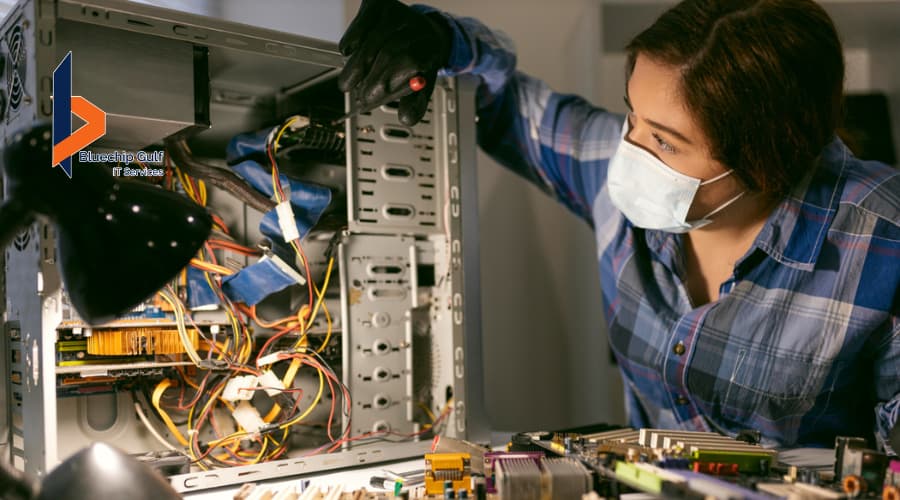
In today’s technology-driven business landscape, having trustworthy IT support is essential for the smooth functioning of your organization. However, when it comes to choosing the right IT support model, businesses often face a dilemma between remote and onsite services. There are benefits and concerns to each approach. In this blog post, we will explore the factors to consider when deciding between remote and onsite IT support, helping you make an informed decision that aligns with your business needs and goals.
What is Remote IT Support?
Remote IT support directs the requirement of technical help and troubleshooting services by IT professionals who are located off-site or remotely. Instead of physically being present at the business location, remote IT support technicians use various tools and technologies to access and control the computer systems and networks of the organization. This allows them to analyze and determine technical problems, provide guidance, and offer solutions without the requirement for an on-site visit.

Remote IT support typically involves communication through phone calls, emails, or chat platforms to understand the problem and gather relevant information. The technicians use remote desktop software, virtual private networks (VPNs), or cloud-based platforms to remotely access the affected systems. By gaining access to the user’s computer or network, they can troubleshoot, configure settings, install software, perform updates, and address any other technical needs.
Benefits of Remote IT Support?
Remote IT support offers a number of advantages to businesses.
- Quick Issue Resolution
With remote IT support, technical issues can be addressed promptly. IT professionals can remotely access and troubleshoot systems, diagnose problems, and provide solutions in real-time. This leads to faster issue resolution, minimizing downtime, and ensuring the smooth operation of business processes. - Cost-Effectiveness
Remote IT support removes the requirement for on-site visits, decreasing travel expenses and associated costs. It is often offered as a subscription-based service, allowing businesses to scale their support according to their needs and budget. This cost-effective approach can be especially beneficial for small and medium-sized businesses with limited resources. - Convenient Access to Expertise
Remote IT support provides access to a diverse team of trained specialists with specializations in various fields of IT. Businesses can tap into this collective knowledge and experience without the need to hire dedicated in-house IT staff. Remote support providers often have specialized technicians available to handle various aspects of IT, ensuring comprehensive assistance for a wide range of technical issues. - Increased Productivity
By resolving IT issues remotely and promptly, remote IT support helps to minimize downtime and disruptions. Employees can continue working without significant interruptions, leading to enhanced productivity and efficiency within the association. - Flexibility and Availability
Remote IT support is typically available 24/7 or during extended hours. This flexibility ensures that businesses can receive assistance whenever they need it, including outside of regular business hours. It is particularly beneficial for organizations with employees working in different time zones or businesses that operate non-traditional hours. - Proactive Monitoring and Maintenance
Many remote IT support providers offer proactive monitoring services, where they continuously monitor the health and performance of systems. This allows them to catch possible problems prior to they become major problems and take preventive measures. Proactive maintenance can help optimize system performance, enhance security, and minimize the risk of unexpected IT issues. - Geographical Flexibility
Remote IT support transcends geographical boundaries. Businesses can access support from anywhere, regardless of their physical location. This is specifically beneficial for companies with numerous locations or remote teams. It enables consistent IT support across the organization, ensuring that all employees receive the assistance they need, regardless of their location.
What is Onsite IT Support?
Onsite IT support refers to technical assistance and troubleshooting services that are provided by IT professionals who physically visit the location where the technical issue or task needs to be addressed. Unlike remote IT support, which is conducted remotely or off-site, onsite IT support involves the presence of IT technicians at the physical premises of the business or organization.

Onsite IT support is typically required for situations that cannot be resolved remotely, such as hardware installations, repairs, network infrastructure setup, or physical maintenance tasks. It may also be necessary when there are limitations on remote access due to security or privacy concerns.
Benefits of Onsite IT Support
- Hands-on Problem Solving
Onsite IT support allows technicians to directly interact with the hardware, software, and network infrastructure on-site. They can physically assess the situation, diagnose issues, and provide immediate solutions. This hands-on approach ensures a more thorough and effective problem-solving process. - Quick Response and Resolution
Onsite support enables rapid response times, particularly for urgent or critical issues. Technicians can be dispatched to the location timely, decreasing downtime and decreasing the effect on business functions. The capability to manage issues in real-time leads to faster issue resolution and increased productivity. - Tailored Solutions and Personalized Assistance
Onsite IT support offers personalized assistance prepared to the precise requirements of the business. Technicians can gain a better understanding of the organization’s infrastructure, workflows, and unique requirements by being physically present. This enables them to provide customized solutions and guidance that align with the business objectives. - Physical Maintenance and Upgrades
Some IT tasks, such as hardware installations, upgrades, or physical maintenance, require onsite presence. Onsite IT support ensures that these tasks are performed accurately and efficiently. Technicians can handle hardware repairs, install new equipment, configure network components, and perform other physical tasks that cannot be accomplished remotely. - Enhanced Communication and Collaboration
Onsite support fosters direct communication and collaboration between IT professionals and end-users or stakeholders. This face-to-face interaction enables a better understanding of user issues, effective knowledge transfer, and efficient troubleshooting. It also allows IT staff to build relationships and provide in-person training or guidance to users. - Network and Security Assessments
Onsite IT support provides an opportunity to conduct comprehensive network assessments and security audits. Technicians can assess the network infrastructure, identify vulnerabilities, and propose necessary upgrades or security measures. This proactive approach helps businesses mitigate risks and strengthen their overall IT environment. - Seamless Integration and Implementation
Onsite support is beneficial during the integration or enactment of new technologies or systems. Technicians can work closely with the business’s IT team to ensure a smooth transition, address any compatibility issues, and provide hands-on support during the implementation process. This minimizes disruptions and facilitates a thriving rollout. - Physical Security Considerations
Certain businesses or industries have strict physical security requirements. Onsite IT support ensures that sensitive data and systems remain within the confines of the organization’s premises, mitigating potential risks associated with remote access or data transmission.
The Best IT Support for Your Business
Deciding between onsite and remote IT support depends on your business type. Small-to-medium enterprises often benefit from remote IT support as it allows them to focus on core processes while leaving IT issues to a dedicated remote team. Remote support teams are well-versed in security updates, firewalls, and intrusion detection systems, minimizing extra work for a small team. On the other hand, big businesses with established budgets and logistics may prefer onsite IT support to address larger processes and mitigate potential risks promptly. Ultimately, the decision should be based on thorough research, considering the special requirements of your business.
Also Read: 5 Reasons Why Businesses Require Firewalls Systems

